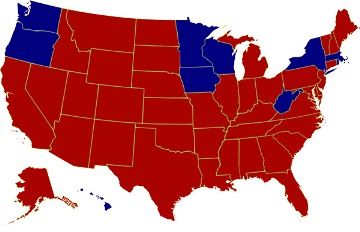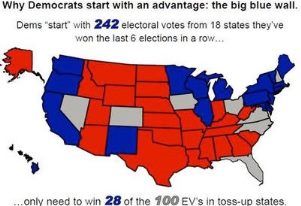
In the wake of the recent elections: an essay by a conservative analyst that is making the rounds, after the jump ….
An article by a conservative pundit has received some notice across the blogosphere; even mentioned in this DK diary recently. He wasn’t the only pundit noting this, and I’d like to mention them (as well as some additional context to be looked at). And part of which is: a look at the 1988 electoral college map …. which seems hard-to-believe, more than twenty-five years on.
First, let’s consider a 2001 book entitled The Last Campaign: How Harry Truman Won the 1948 Election by Zachary Karabell. And while most political junkies read it for the second part of the title …. I was drawn to it by the first part of the title. (You may well find it at your public library or available on interloan).

The notion of a “last campaign” came to Karabell during his research, where he saw (in hindsight) that 1948 was the end-of-an-era of presidential campaigning. Not something one could sense right away …….. but with the passing of time, it was clear that the 1952 election was different. Some of the changes he noted:
1) 1948 was the last time a presidential race would be dominated by radio and print media. Television was still an infant technology, which would only begin to emerge in 1952.
2) 1948 was the last campaign where the railroad “whistle stops” were a prime means of travel. Air travel began to become more important by 1952.
3) The 1948 conventions marked “the end of a particular type of back-room politics, the end of the hidden convention.” The smoke-filled rooms began to fade with the increasing importance of the party primary system. For example, the first New Hampshire primary was in 1916, but it wasn’t until 1952 that it really attracted attention: when the candidates’ actual names were listed on the ballot (unlike before when only unknown party reps were listed). Turnout more than doubled in 1952 and the results were announced on national TV.
4) 1948 was the last time progressive and far-Left viewpoints were openly debated and covered in the mainstream press, before the Cold War consensus placed an entire spectrum of political views beyond the pale. Henry Wallace was head of the Progressive Party, the governor of South Carolina (Strom Thurmond) was part of a party that was referred to as the Dixiecrats, and also on the ballot (in a lot of states) was the old-time Socialist, Norman Thomas.
5) Finally, 1948 was the last time the pollsters so miscalled a presidential election. Modern polling was born in the wake of that election.
If you fast-forward an additional forty years to 1988, I believe we can see another end-of-an-era in politics. This was during the victory of George Bush the Elder vs. Mike Dukakis, with this Electoral College map.

An essayist in Bloomberg News noted:
Bush, who won 40 states, 426 electoral votes and 53.4 percent of the popular vote, got a bigger vote percentage in Florida (60.9%), his fifth-best state, than in Wyoming (60.5%). In 2012, Florida was the closest state and Wyoming was Republican nominee Mitt Romney’s second-best state in his losing effort against President Barack Obama.
Bush did better in New Jersey (56.2%) than in North Dakota (56.0%) – unthinkable for a Republican presidential candidate today. Dukakis did better in West Virginia (52.2%) than in New York (51.6%). He did better in Iowa (54.7%), where the farm economy faltered during the 1980s, than in his native Massachusetts (53.2%).
I recall reading about the strategy during Bill Clinton’s 1992 run for president, with analysts talking about holding the “Dukakis Ten” (states) and building from there. Needless to say, they succeeded.
What they were able to achieve was to add (to those ten states) the likes of California, Illinois, New Jersey, Michigan, Vermont, Connecticut, Delaware, Maine and Pennsylvania … who have held solid ever since. (Only West Virginia has left the Dukakis Ten since).
But don’t just listen to Democratic strategists on this: GOP pundit David Gergen wrote this on the morning of Election Day, advising GOP hopefuls to beware the “Blue Wall”:
The blue wall is a powerful phalanx of 18 states and the District of Columbia that have voted for the Democrats in every single presidential election for 20 years — six straight. Some states have been in the Democratic column even longer.
It’s not just the number of blue states but how huge an advantage they provide for the Democratic presidential nominee. Altogether, these 18 states plus the District of Columbia account for 242 electoral votes — just 28 shy of the 270 magic total required to win the White House. If the wall holds firm, the Democratic nominee only has to win a handful of purple states to go over the top. Florida’s 29 electoral votes alone would seal the election.

Note: the map above misidentifies New Mexico as part of the six-election-straight Blue Wall. Or …….. does it any longer? Read on.
With that in mind, let’s look at the recent buzz – a conservative pundit named Chris Ladd has gone even further than Gergen. For those who have not read it: in an essay published in the Houston Chronicle he argues thusly:
– Republican Senate candidates lost every single race behind the Blue Wall. Every one.– Behind the Blue Wall there were some new Republican Governors, but their success was very specific and did not translate down the ballot.
– Vote suppression is working remarkably well, but that won’t last. Eventually Democrats will help people get the documentation they need to meet the ridiculous and confusing new requirements. The whole ‘voter integrity’ sham may have given Republicans a one or maybe two-election boost in low-turnout races. Meanwhile we kissed off minority votes for the foreseeable future.
– Across the country, every major Democratic ballot initiative was successful, including every minimum wage increase, even in the red states. Every personhood amendment failed.
More pertinently, he suggests the Blue Wall is now even larger, adding Nevada (6 EV) plus New Mexico (5 EV) as shown on his own-generated electoral college map …. and then he went on to write:

The Blue Wall is block of states that no Republican Presidential candidate can realistically hope to win. Tuesday that block finally extended to New Hampshire, meaning that at the outset of any Presidential campaign, a minimally effective Democratic candidate can expect to win 257 electoral votes without even trying. That’s 257 out of the 270 needed to win.
Arguably Virginia now sits behind that wall as well. Democrats won the Senate seat there without campaigning in a year when hardly anyone but Republicans showed up to vote and the GOP enjoyed its largest wave in modern history. Virginia would take that tally to 270. Again, that’s 270 out of 270.
He cited no statistics or reports for declaring Nevada and New Mexico as hopelessly lost to the GOP (possibly due to their growing Latino populations?) nor anything on New Hampshire.
As a 27-year resident, I have certainly seen New Hampshire become more blue up-ballot. In fact it has voted Democratic 5 of the past 6 elections (post-1988) and would be part of the Blue Wall had not Al Gore abandoned his campaign here early in 2000, only to see the results become: a Bush win by only 7,000 votes (a 1.2% margin). Many of us here believe that simply competing as if it were a competitive state … history may have been different. Although he did not prevail in 2004, John Kerry did pay attention and won the Granite State by 9,000 votes (a 1.4% margin) despite the “terrorists will kill us all” Bush campaign that was persuasive elsewhere.
In 2012, Barack Obama won by a 5.5% margin …. and this year we did hold onto the governor’s race (Maggie Hassan), US Senate (Jeanne Shaheen) and the 2nd of the state’s two congressional districts (Ann Kuster, my representative), bucking national trends.
We did lose Carol Shea-Porter’s 1st congressional seat, perhaps the nation’s most competitive district (and more conservative than mine). If she runs again in 2016, she probably wins.
So, it may be a stretch to consider the Granite State beyond GOP reach …. yet I will not complain if it becomes so. The notion of merely having to “hold serve” on our Blue Wall and seek opportunities elsewhere is a comforting thought after what we went through this month. Plus, the notion that we can choose a capable candidate – rather than a “perfect” candidate – is also encouraging.
9 comments